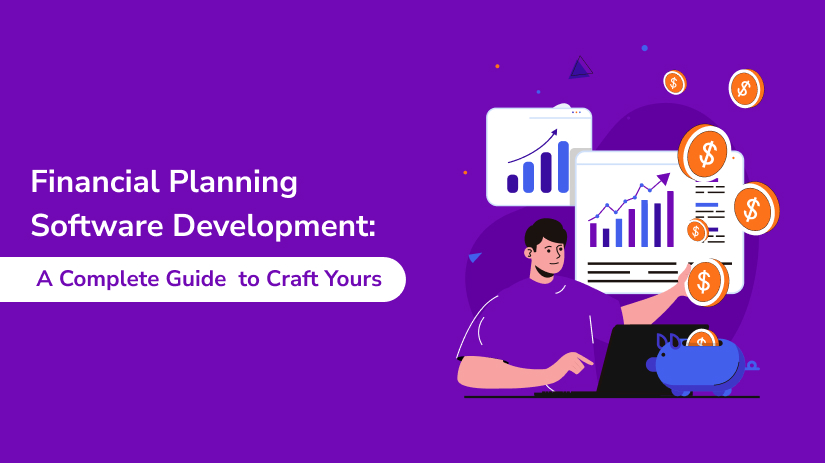In today’s fast-paced digital age, effective financial planning is crucial for both individuals and businesses.
The demand for robust financial planning software has soared, driven by the need for precise financial management, strategic planning, and informed decision-making.
Developing financial planning software is a complex process that requires a strategic approach, the right technology stack, and a thorough understanding of financial technology services.
This guide will walk you through the essential steps and considerations for crafting your financial planning software.
Understanding Financial Planning Software Development
Financial planning software Development helps users manage their finances, forecast future financial conditions, and make informed decisions. These tools are designed to handle a range of tasks, including budgeting, investment planning, tax planning, and retirement planning. By providing comprehensive insights and analytics, financial planning software empowers users to optimize their financial health.
Connect with us for Fintech Development Needs
Trusted by companies like Plaid, Yodlee, Codat.
Key Features of Financial Planning Software
Before diving into the development process, it’s essential to outline the key features that your financial planning software should offer:
- Budgeting and Forecasting: Allow users to create budgets and forecast future expenses and incomes.
- Investment Tracking: Enable users to track their investments and analyze their performance.
- Tax Planning: Provide tools to help users plan and optimize their taxes.
- Retirement Planning: Help users plan for their retirement by forecasting savings and expenditures.
- Goal Setting: Allow users to set and track financial goals.
- Reporting and Analytics: Offer comprehensive reports and analytics for better financial insights.
Steps to Develop Financial Planning Software
Market Research and Requirement Analysis
Begin with thorough market research to understand the current trends, user needs, and competition in the financial planning software market. Identify the unique features that will set your software apart.
Conducting a requirement analysis will help you define the scope of the project and determine the essential features and functionalities.
Choose the Right Technology Stack
Selecting the appropriate technology stack is crucial for the success of your financial planning software.
Ruby on Rails development is a popular choice for financial application development due to its flexibility, scalability, and security features. It allows for rapid development and deployment, making it ideal for financial technology services.
Design the User Interface
The user interface (UI) plays a critical role in user experience (UX). Design an intuitive and user-friendly interface that makes it easy for users to navigate through the software. Ensure that the design is responsive, accessible, and visually appealing.
Develop the Core Functionality
Start with the development of core functionalities such as budgeting, forecasting, investment tracking, and reporting. Utilize Ruby on Rails to build a robust and scalable backend that can handle complex financial data and processes efficiently.
Integrate Security Features
Security is paramount in financial planning software. Implement robust security measures to protect user data and ensure compliance with regulatory standards. Use encryption, secure authentication, and regular security audits to safeguard sensitive financial information.
Test Thoroughly
Conduct comprehensive testing to identify and fix any bugs or issues. Perform unit testing, integration testing, and user acceptance testing (UAT) to ensure that the software functions as expected and provides a seamless user experience.
Deploy and Maintain
Once testing is complete, deploy the software to the production environment.
Provide continuous support and maintenance to address any issues that may arise and to keep the software updated with the latest features and security patches.
Connect with us for Fintech Development Needs
Trusted by companies like Plaid, Yodlee, Codat.
Leveraging Financial Technology Services
Collaborating with financial technology services can significantly enhance the development process.
These services offer expertise in areas such as compliance, security, and integration, ensuring that your software meets industry standards and user expectations.
Exploring Niche Applications: Donor Manager Software
In addition to general financial planning software, consider developing niche applications such as donor manager software.
This type of software is tailored for non-profits and charitable organizations, helping them manage donations, track donor engagement, and generate reports.
By addressing specific needs within the financial sector, you can tap into niche markets and provide specialized solutions.
Conclusion
Developing financial planning software is a multifaceted process that requires careful planning, the right technology, and a user-centric approach.
By following this comprehensive guide, you can create powerful financial planning tools that cater to the diverse needs of users.
Whether you’re focusing on general financial planning or specialized applications like donor manager software, the key is to deliver value through innovation, security, and user experience.
With the increasing demand for financial planning tools, there has never been a better time to invest in financial application development.
Leverage Ruby on Rails development and financial technology services to build robust, scalable, and secure software that empowers users to take control of their financial future.
Happy Financial Development!!
Connect with us for Fintech Development Needs
Trusted by companies like Plaid, Yodlee, Codat.





